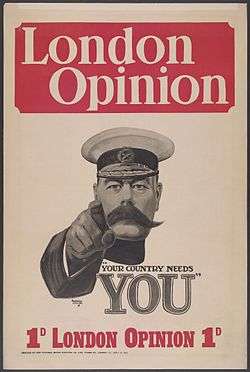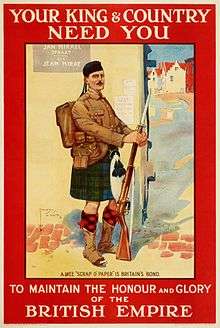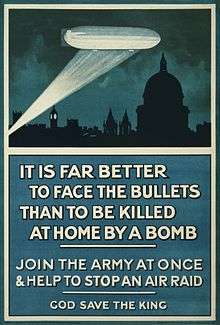Recruitment to the British Army during the First World War

At the beginning of 1914 the British Army had a reported strength of 710,000 men including reserves, of which around 80,000 were regular troops ready for war. By the end of the First World War almost 1 in 4 of the total male population of the United Kingdom of Great Britain and Ireland had joined up, over five million men. Of these men, 2.67 million joined as Volunteers and 2.77 million as conscripts (although some volunteered after conscription was introduced and would most likely have been conscripted anyway). Monthly recruiting rates for the army varied dramatically.
August 1914
For a century, British governmental policy and public opinion was against conscription for foreign wars. At the start of World War I, the British Army consisted of six infantry divisions,[1] one cavalry division in the United Kingdom formed after the outbreak of war,[2] and four divisions overseas. Fourteen Territorial Force divisions also existed, and 300,000 soldiers in the Reserve Army. Lord Kitchener, the Secretary of State for War, considered the Territorial Force untrained and useless. He believed that the regular army must not be wasted in immediate battle, but instead used to help train a new army with 70 divisions—the size of the French and German armies—that he foresaw would be needed to fight a war lasting many years.[1]
Volunteer Army, 1914–15

The British had about 5.5 million men of military age, with another 500,000 reaching 18 each year.[4] The initial call for 100,000 volunteers was far exceeded, almost half a million men enlisted in two months (see the graph). Around 250,000 underage boys also volunteered; either by lying about their age or giving false names which recruiters often turned a blind eye to.[5]
One early peculiarity was the formation of 'pals battalions': groups of men from the same factory, football team, bank or similar, joining and fighting together. The idea was first suggested at a public meeting by Lord Derby. Within three days, he had enough volunteers for three battalions. Lord Kitchener gave official approval for the measure almost instantly and the response was impressive. Manchester raised nine specific pals battalions (plus three reserve battalions); one of the smallest was Accrington, in Lancashire, which raised one. One consequence of pals battalions was that a whole town could lose its military-aged menfolk in a single day of battle.[6]
.jpg)
The women's suffrage movement was sharply divided, the slight majority becoming very enthusiastic patriots and asking their members to give white feathers (the sign of the coward) in the streets to men who appeared to be of military age to shame them into service. After assaults became prevalent the Silver War Badge was issued to men who were not eligible or had been medically discharged.
The popular music hall artistes of the time worked enthusiastically for recruitment. Harry Lauder toured the music halls, recruiting young soldiers on stage in front of the audience, often offering 'ten pounds for the first recruit tonight'. Marie Lloyd sang a recruiting song I didn't like you much before you joined the army, John, but I do like you, cockie, now you've got yer khaki on (1914). Vesta Tilley sang The Army of Today's alright.

The available pool was diminished by roughly 1.5 million men who were "starred": kept in essential occupations. Almost 40 percent of the volunteers were rejected for medical reasons. Malnutrition was widespread in society, working class 15‑year‑olds had a mean height of 160 cm, while the upper class was 171 cm.[8]
From the first Kitchener insisted that the British must build a massive army for a long war. He argued that the British were obligated to mobilize to the same extent as the French and Germans. His goal was 70 divisions and the Adjutant General asked for 92,000 recruits per month, well above the number volunteering (see the graph). The obvious remedy was conscription, which was a hotly debated political issue. Many Liberals, including Prime Minister H. H. Asquith, were ideologically opposed to compulsion. By 1915 they were wavering. In summer 1915 every man aged 18 to 41 was recorded under the National Registration Act. A pink card for each man listed his pertinent data.[9]
The Cabinet were given a strong warning in September 1915 in a paper presented by their only Labour member, Minister of Education Arthur Henderson.[10] He argued many working men would strongly resist serving a nation in which they did not have a legitimate share in governing. They resented the idea of being dragooned to face possible death by a Parliament they had no part in electing—forty percent of men over 21 were denied the vote by the franchise and registration laws (until the Representation of the People Act of 1918). To them conscription was yet another theft of working men's rights by rich capitalists. The only telling counterargument the government could offer was absolute necessity. Workers must be convinced that there were too few volunteers to meet the need, so they would lose the war, which would mean the end of Britain; army leaders should convince union leaders by laying out the military facts.
The Derby Scheme

The Derby Scheme was launched in autumn 1915 by the Earl of Derby, by then Kitchener's new Director General of Recruiting, to determine whether British manpower goals could be met by volunteers or if conscription was necessary.[11] Each eligible man aged 18 to 41 who was not in a "starred" (essential) occupation had to make a public declaration.
When the scheme was announced there was a surge in recruiting because many men volunteered without waiting to be ‘fetched’. It was a huge undertaking. Each eligible man’s blue card from the recently completed National Register was copied onto a pink card, which was sent to his local constituency's Parliamentary Recruiting Committee. The Committees appointed canvassers who were "tactful and influential men" not liable for service; many were experienced political agents. Discharged veterans and fathers of serving men proved most effective. A few canvassers threatened rather than cajoled. Women were not permitted to canvas but did track men who had moved.[12]
Each man was handed a letter from Derby explaining the programme, emphasizing that they were in "… a country fighting, as ours is, for its very existence ...".[13] Face to face with the canvasser each man announced whether or not he would attest to join the forces – no one was permitted to speak for him. Those who attested promised to go to the recruiting office within 48 hours; many were accompanied there immediately. If found fit they were sworn in and paid a signing bonus of 2s 9d. The following day they were transferred to Army Reserve B. A khaki armband bearing the Royal Crown was to be provided to all who had enlisted or who had been rejected, as well as to starred and discharged men (they were no longer issued or worn after compulsion was introduced).
The enlistee’s data was copied onto a new white card which was used to assign him to one of 46 age groups consisting of married or unmarried men. They were promised that only entire groups would be called for active service and they would have fourteen days' advance notice. Single men's groups would be called before married; any who wed after the day the Scheme began were classified as single. Married men were promised that their groups would not be called if too few single men attested, unless conscription was introduced. The survey was done in November and December 1915. It obtained 318,553 medically fit single men.[14] However, 38% of single men and 54% of married men had publicly refused to enlist.
Conscription 1916–18
Since there were too few volunteers to fill the ranks, the Military Service Bill was introduced in January 1916, providing for the conscription of single men aged 18–41. Every single man and childless widower between 18 and 41 was offered three choices:
- Enlist at once.
- Attest at once under Derby’s system.
- Or on 2 March 1916 be automatically deemed to have enlisted.
In May 1916 the bill was extended to married men and in April 1918 the upper age was raised to 50 (or to 56 if need arose). Ireland, which was part of the United Kingdom at the time, was excluded from the scheme.
As Henderson had warned compulsion did not go smoothly. By July 1916 93,000 (30%) of those called had failed to appear, that summer and autumn likely-looking men in public places were rounded up.[15] It was primarily a protest, since few of the no-shows could have hoped to escape, although a few were hidden by sympathizers.[16]
Men called up for military service or their employers could appeal to a civilian Military Service Tribunal in their town or district on the grounds of work of national importance, business or domestic hardship, medical unfitness, or conscientious objection. By the end of June 1916, 748,587 men had appealed.[17] The standards of the tribunals were capricious: in York a case was determined in an average of eleven minutes, two minutes was the rule at Paddington in London.[18]

Although it has been the focus of the tribunals' image since the war, only two percent of those appealing were conscientious objectors. Around 7,000 of them were granted non-combatant duties, while a further 3,000 ended up in special work camps. 6,000 were imprisoned. Forty two were sent to France to potentially face a firing squad. Thirty five were formally sentenced to death, but immediately reprieved, with ten years penal servitude substituted.
Many of those appealing were given some kind of exemption, usually temporary (between a few weeks and six months) or conditional on their situation at work or home remaining serious enough to warrant their staying at home. In October 1916 1.12 million men held tribunal exemption or had cases pending,[20] by May 1917 this had fallen to 780,000 exempt and 110,000 pending. At this point 1.8 million men were exempted, more men than were serving overseas with the British Army.[21] Some men were exempted on the condition that they joined the Volunteer Training Corps for part-time training and home defence duties; by February 1918, 101,000 men had been directed to the Corps by the tribunals.[22]
A newspaper report on 17 February 1916 listed five sample appeals for exemption from conscription, and their results.[23]
| Appealer(s) | On behalf of | Plea | Result of plea |
|---|---|---|---|
| a firm of art dealers | their clerk | busy with a big export trade | appeal rejected |
| Royal Academy | W. R. H. Lamb (its secretary) | busy with 12,000 incoming works; no available replacement | his conscription was delayed 3 months |
| a tobacco and cigarette manufacturers | their blender | "we supply army officers" | appeal rejected |
| Oswald Stoll | J. P. Seaborn (artist and photographer) | busy making images, etc. for Mr. Stoll's theatres | wait while accumulating a list of about 40 appealed employees |
| Mr. Brenman (clog dancer, member of the music hall act Five Dorinos) | needed to hold group together | his conscription was delayed 1 month | |
In 1917 the Commons passed a bill to give the vote to all males over 21 (and to many women as well), but it did not become law until 6 February 1918. In the same month occupational exemptions were withdrawn for men 18 to 23, in October 1918 there were 2,574,860 men in reserved occupations. Men aged 18½ were sent to the fronts starting in March 1918, violating a pledge to keep them safe until 19. There were also problems with men’s suitability for active service. The healthy manpower was simply not there – recruits were sorted into three classes, A, B, and C, in order of fitness for front-line service. In 1918, 75 percent were classed as A, some B men also had to be sent into the trenches.
The upper limit on the number of men conscripted is usually calculated by assuming that all recruits after 1 March 1916 were conscripts: 1,542,807 men, 43.7% of those who served in the Army during the war. However, Derby had enlisted 318,553 single men in Special Reserve B, who were called up in spring 1916, which reduces the conscripted to 37%. The married men who had attested in the Derby plan are harder to categorize because they were not called up from the Reserve but swept up with the rest. It seems that somewhat less than 35% of the men in the army were compelled to serve.
Ireland
In 1918, legislation intended to extend conscription to Ireland was opposed by a broad movement of Irish nationalists and the Catholic Church in Ireland. The central role of Sinn Féin in this movement boosted its popularity in the buildup to the November general election.
Recruiting staff
Notable men who served as army recruiters during the war included:
- Sergeant John Doogan, Victoria Cross recipient
- Captain Samuel Hoare, later intelligence officer and Conservative politician
- Major Lionel Nathan de Rothschild, banker and Conservative MP (awarded OBE for his services)
See also
References
- 1 2 Tuchman, Barbara (1962). The Guns of August. New York: Random House. pp. 231–233.
- ↑ Becke, Major A.F. (1935). Order of Battle of Divisions Part 1. The Regular British Divisions. London: His Majesty's Stationery Office. p. 6. ISBN 1-871167-09-4.
- ↑ Te Papa (the Museum of New Zealand)'s description of the poster.
- ↑ Peter Simkins, Kitchener's Army: The Raising of the New Armies 1914–1916 (Manchester, Manchester University Press: 1988
- ↑ "How did Britain let 250,000 underage soldiers fight in WW1?". iWonder. BBC. Retrieved 30 August 2018.
- ↑ Adrian Gregory, The Last Great War (Cambridge, Cambridge University Press: 2007)
- ↑ Great Britain, The War Office, Statistical Abstract of information regarding the British Armies at home and abroad 1914–1920.’ . London: HMSO, 1920.
- ↑ Floud, R. Height, Health and History. Cambridge University Press, 1990.
- ↑ Beckett, I. F. W. "The real unknown army. British conscripts 1916–1990." The Great War, 1914–1918: the Illustrated Journal of First World War History, 2 (1988): 4–13.
- ↑ National Archives, CAB/37/134/5.
- ↑ "Recruiting Supplement" Times (London) Special Supplement, 3 November 1915.
- ↑ Manchester Guardian October and November 1915.
- ↑ Times (London) Special Supplement, 3 November 1915 p. 3.
- ↑ National Archives, CAB 37/140/1.
- ↑ Beckett, 1988
- ↑ Rippon, N. The plot to kill Lloyd George : the story of Alice Wheeldon and the pear tree conspiracy. Barnsley: Wharncliffe Books, 2009.
- ↑ J.E. Edmonds, Military Operations: France and Belgium: 1916, vol. i (London: 1932), p.152.
- ↑ Beckett, 1988, p.7.
- ↑ War Office,1920
- ↑ The National Archives, CAB 17/158, Derby scheme: Statement of the War Committee, 24 October 1916
- ↑ Statistics of the Military Effort of the British Empire during the Great War. 1914–1920 (London: 1922).
- ↑ Beckett, I. F. W. (1985). A Nation in Arms: A Social Study of the British Army in the First World War. Manchester University Press. p. 31. ISBN 978-0-7190-1737-7. Retrieved 30 August 2018.
- ↑ Daily Telegraph Thursday 17 February 1916, reprinted in Daily Telegraph Wednesday 17 February 2016 page 26
External links
| Wikimedia Commons has media related to World War I recruitment in the United Kingdom. |